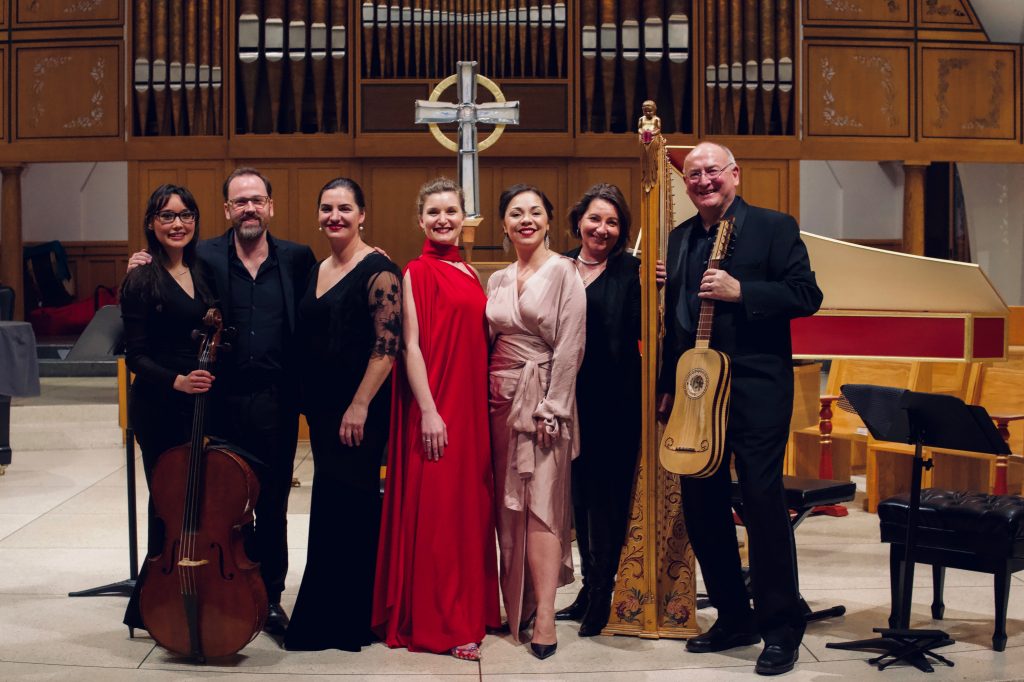By Philippa Kiraly, Special to The Sybaritic Singer
The concert given by Pacific MusicWorks on Friday, March 1, 2019 at St. Stephen’s Episcopal Church in the Laurelhurst district of Seattle contained works never heard in this country before, some never before heard outside the immediate milieu in which they wrote, and some of them never heard before at all.
They are worth hearing: these are works by composers from the 16th and early 17th centuries, all of whom are women. Barbara Strozzi, Francesca Caccini, Isabella Leonarda, Elisabeth Jacquet de la Guerre are women whose names are at least a little familiar. Antonia Bembo and Maria Xaveria Peruchona we know not at all. The Strozzi and Caccini names we know because their fathers are well known, Giulio Caccini as a composer of that day, Giulio Strozzi as a major opera librettist, and both encouraged their daughters. All the women on the program except France’s Jacquet de la Guerre were Italian and all the works are every bit as worthy of performance as those of the male composers of the same era and countries.
L-R: Caroline Nicolas, Adam LaMotte, Tekla Cunningham, Danielle Sampson, Tess Altiveros, Maxine Eilander, Stephen Stubbs. Missing from photo: Henry Lebedinsky. Photo credit: Elisabeth Ellis
Appropriately enough, the concert was given on the first day of Women’s History Month 2019 in the U.S and just a week before International Women’s Day, March 8. The soloists were women also, sopranos Tess Altiveros and Danielle Sampson, both frequent performers with Pacific MusicWorks and both skilled at singing in baroque style with the specific types of ornamentation used at the time. Most of this is intentionally improvisatory but requires the performers to be steeped in understanding how, where and when specific ornaments were used and it is fortunate that there are treatises of the day which are explanatory in that respect. It’s as though today’s classical singers needed also to internalize the rules of singing gospel riffs, the knowhow to sing scat and to do both supremely well.
Caccini, active at the same time as Monteverdi, and Strozzi, a full generation younger, both adhered to the current style of creating vocal works largely based in classical myth. They wrote songs of love—extolling the pleasures of love, languishing with love, disillusion, frustration, despair or pleading with the object of love. Perhaps the most enlightening performance of the evening was Strozzi’s “Lagrime mie” (“My tears”) sung by Altiveros. The program had begun with an excerpt from the first opera ever composed by a woman, right at the beginning of opera as a genre: Caccini’s “Sirena” from La liberation di Ruggiero, where the music mirrors the words of enticement, seductively sung by Sampson.
“Lagrime mie” from just a generation later shows clearly the ferment of musical development occurring at the time. It’s more harmonically adventurous, emotional and exciting, the writing dramatic. Altiveros’ performance was nothing short of thrilling as she described the torment of unrequited love.
Peruchona was a nun in the latter half of the 17th century when music was one of the few emotional outlets available to female religious communities and as such it flourished with some notable music emerging, much of it hardly ever heard today. Peruchona’s “O quam dulce” (“O how sweet”) is surprisingly warlike, though it is an allegory of the singer’s victory over fleshly delights rather than active warfare. A wonderfully animated work, it is a duet. Bembo’s was the only work with no mythic or religious context. “Chiaro esempio di gloria” (“Bright exemplar of glory”) is frankly sycophantic, with reason probably. Bembo had moved to France where Louis XIV had granted her a pension and perhaps this was a grateful response.
Altiveros’ and Sampson’s voices are distinctly different. Where Altiveros’s voice has a wider range of depth, Sampson’s has a leaner sound and they approach creating emotional content differently.
Both use vibrato sparingly, both are expressive and nuanced in their singing, and have an equally high and easy range, though Sampson has a slight rough edge to her voice which is more ubiquitous than it needs to be in anything louder than fairly soft.
In between the vocal works, Pacific MusicWorks musicians played sonatas by Leonarda and Jacquet de la Guerre, with varying combinations of two violins, Tekla Cunningham and Adam LaMotte, Maxine Eilander on baroque harp, Caroline Nicolas, baroque cello and viola da gamba and Henry Lebedinsky, harpsichord and organ, all led by PMW’s music director Stephen Stubbs, baroque guitar and lute. These two instrumental composers overlapped with Bach, who may well have known and studied works by both of them. The works had more and shorter sections than sonatas today, and quite a few of these from both composers used the relatively new form of a brief repeated bass line, the passacaglia or chaconne, which came into fashion from Spain about the time they were writing.
The whole concert was full of interest, fresh to the ears, splendidly performed in a church new to PMW but with excellent acoustics. One hopes they will perform here again.
 Philippa Kiraly has writing classical music criticism since 1980, for several newspapers in northern Ohio and Seattle, magazines, both local and national, and blogs. She is passionate about the importance of independent criticism for the fine arts, an art in itself which is dying with little interest by many publications and no longer a viable career for most. But writing for tickets is always worthwhile!
Philippa Kiraly has writing classical music criticism since 1980, for several newspapers in northern Ohio and Seattle, magazines, both local and national, and blogs. She is passionate about the importance of independent criticism for the fine arts, an art in itself which is dying with little interest by many publications and no longer a viable career for most. But writing for tickets is always worthwhile!
Pippa is a keen gardener, a keen grandparent, and can get lost in a good book.

